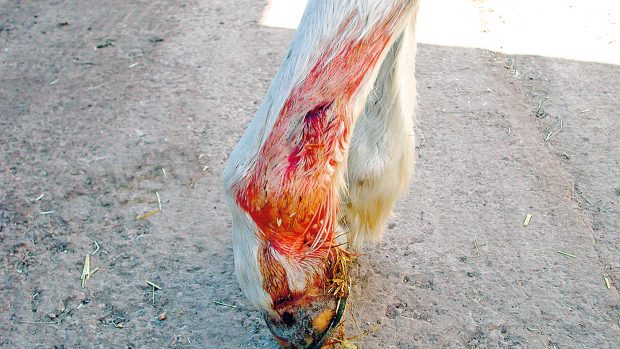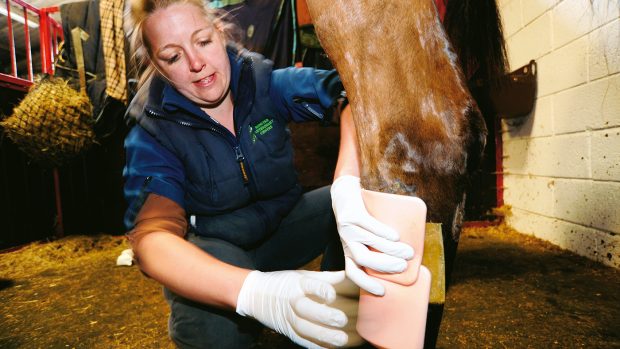Every horse owner should have a good understanding of basic first aid techniques to use when an injury is discovered. It may provide help straight away for an obviously serious emergency until the vet arrives or can be used to treat minor injuries that are unlikely to need a vet.
If in doubt, consult your vet. Horse owners need to know how to recognise a serious injury and how to respond with the appropriate first aid until a vet can attend.
When a horse is cut and bleeding badly, the problem is obvious, but in cases of colic, illness or a more subtle injury, it can be more difficult to assess how distressed the horse actually is.
It is therefore important to know your horse’s normal vital signs, including temperature, pulse and respiration, so you can easily detect any changes.
Similarly, make sure you are aware of their normal behaviour patterns, so that you can spot differences.
Owners should:
- know how to contact your vet in an emergency
- know where or how you can obtain horse transport in a hurry
- keep a well-stocked first aid kit available
Taking action
The most common first aid condition is when a horse sustains a wound.
The immediate action should be to:
- prevent further injury
- control blood loss
- minimise contamination
- maintain cleanliness and reduce the risk of infection.
All but the most severe bleeding can be controlled by applying a clean, dry bandage pad with moderate pressure. If you are out in the middle of nowhere, sacrifice a T-shirt or similar to hold over the wound. If you can tape it in place or hold it there for at least 5min, it should allow blood clotting to occur.
The ideal is to use a sterile or clean bandage to reduce contamination by dirt and dust. This is where dressings from a first aid kit are useful.
First aid rules for wounds
- clot: first stop the bleeding
- check and clean: contamination and infection prevent wounds from healing. If infection penetrates vital structures such as joints or tendon sheaths, a horse may become permanently lame, so it is vital to check carefully the position, depth and severity of any wound. To do this properly, you will need to clean the wound, so that you can see what is involved, provided this can be done without making it bleed further.
- cover: the wound should be covered where possible to protect it. People are often tempted to apply creams and potions on to an injury. It is important to remember that raw tissues are exposed
Wound management
With a wound, always contact your vet if:
- any wound is bleeding profusely
- the horse is very lame, even if the wound is small
- any wound that is more than a couple of inches long and has gone right through the skin, so that it gapes open, may need stitching
- there is any suspicion of a foreign body
- there is any suspicion that a joint may be involved
- the horse has not had an anti-tetanus vaccination.
A wound may need to be stitched if:
- the edges are gaping apart
- it is large or deep
- it is in an awkward place where it will scar.
If you think a wound may need to be stitched, you should consult your vet as soon as possible, since it will heal more effectively if it is sutured while still fresh. However, there is a 6-8hr optimum period for wound repair.
Deep punctures, swollen or crushed wound edges and severely contaminated or infected wounds will not be suitable for suturing, nor will wounds that are more than 8hr old in most cases. Your vet will advise you on this.
Emergency leg support
Leg injuries are another common first aid issue. If a suspected fracture is managed properly, immediately after the initial injury, it may improve the chances of recovery.
If a horse is extremely lame, it is important to prevent it from moving unnecessarily on the damaged leg and exacerbating the injury. Keep the hopping-lame horse as still as possible while help is summoned. Proper immobilisation and support of the injury will help relieve pain.
Inadequate splinting can make an injury worse. With a suspected fracture, your vet may apply a large support bandage, known as a Robert Jones bandage.
It is essential to remember that first aid is the first thing done. Most important of all is ensuring that the horse is not in pain. Treating a wound, supporting a leg injury, good nursing and the correct management as soon as something goes wrong can all speed a successful recovery.



